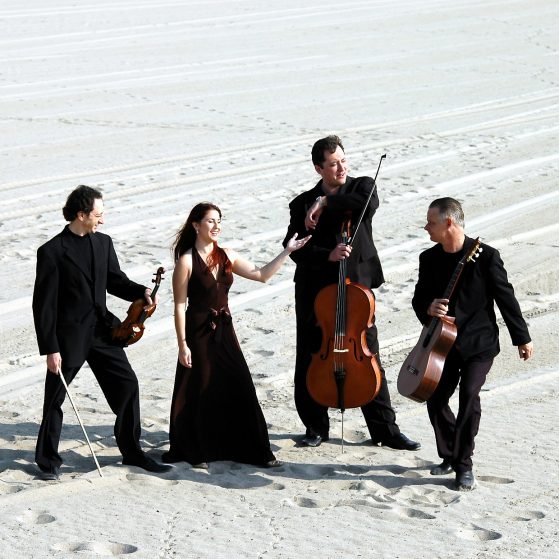Listening to The Red Quartet’s debut album is like taking a journey through time and over borders. The mix of traditional classical and Latin tracks is sure to delight and Marissa Steingold’s vocals are a lesson in vocal freedom.

Natasha Barbieri: Can you tell us about how this group came together?
Philip Vaiman: I met Marissa doing a project for our mutual composer friend. The performance took place in Berkeley, California, which is about 6 hours away from Los Angeles, where we live. It was a last-minute thing, and, as we were driving there, the composer was still sketching out his piece, which largely relied on improvisation. I was deeply impressed with the beauty of Marissa’s voice, her versatility, and improvisation skills. As we were coming back the next day, we were talking about music among other things. Marissa mentioned that one of her areas of expertise is Bossa Nova. I have always loved listening to Jobim and other Brazilian Jazz masters, and we started to discuss the possibility of our collaboration. Marissa mentioned that she would like to explore more Classical music, and I was excited to actually PLAY some Jazz, Bossa, on violin. After that, we completed the group with Kenton on guitar and Maksim on cello.
Natasha Barbieri: How did you come up with the name ‘Red Quartet’?
Philip Vaiman: Some years ago, I was putting together concerts that were based on chamber music, but involved other visual and performance artists, as I tried to achieve a synthesis of different art forms, and showcase my love for the theater. At first, our Quartet was part of that experimentation process, under the whole project’s name “La Camerata: Chamber Music Theater”. Very soon after we started to play together, which felt so right, we have decided to give our ensemble a well-deserved separate trajectory. As with many bands, naming the group could be quite challenging, and an exhausting task. We ended up with “The Red Quartet”. To us, the word ” Red” represents life, excitement, and love. That is how we feel about music that we create together.
Natasha Barbieri: The style of the album reaches from classical to jazz and Latin music. Tell us a little bit about why this particular mix appealed to you?
Philip Vaiman: We are all Classically trained musicians; this is our roots. Both Marissa and Kenton have played Jazz throughout their successful careers. For Maksim and me, as for many Classical musicians, jazz music is something that we would listen to for our enjoyment. We were very enthusiastic about the idea of exploring that genre not only as listeners but as performers. And, living in Los Angeles, California, which is so influenced by Latin culture, language, and food, it felt so natural to bring that to our musical mix.
Natasha Barbieri: Marissa, your voice has incredible agility and an early music purity. What would you say has been the most influential part of your vocal training?
Marissa Steingold: I spent a lot of time listening to Miles Davis as a kid. For Miles, there were seemingly a million ways to play a note: maybe he’d slide into it gently, hit it straight on, veil it in a smoky muted haze, relax into a deep, hedonistic vibrato, add a swinging trill, or stop time with a vibrato-less signal. Practitioners of early music approach tone with a similar spirit of experimentation. What I love is how willing they are to twist and squeeze their voices—even when it might sound ‘ugly’ by bel canto standards. And early music cats really know how to groove!
Natasha Barbieri: Philip, you have performed with some incredible artists including Aretha Franklin, Tony Bennet, and Shakira. Did working with them inspire an interest in crossover and blending genres?
Philip Vaiman: As a classical violinist, there was always a clear separation between classical music, as something that you practice, perform, and dedicate your life to, and other music genres that you would love to listen to and enjoy. The choices for my listening pleasure frequently surprised both musician and non-musician friends, as it could range from Peter Gabriel to Manu Chao to Radioheads. With many stops in between! But my ears, and an understanding of how, I as a violinist, can fit in, and be complementary to an R&B, a country, or a hip-hop song kicked in only after I started working for an agency that would bring string players to record and play with different mainstream, pop artists, and working with amazing arrangers. That experience helped me to blur the line between the music that I was trained to understand and play, with the music that I have loved listening to, enabling me to enjoy a completely different approach to music-making.
Natasha Barbieri: Kenton, you are a guitarist, singer, and producer and also a faculty member at various universities. Are you hopeful that classical crossover phenomena will start becoming more encouraged in higher learning?
Kenton Youngstrom: Absolutely! It’s already happening on several fronts around the world. For example, the Menuhin International violin competition has a round devoted to improvisation: Each competitor is given a unique melody and 15 minutes of solitude before performing an extemporized composition. That’s a hopeful sign, and if other competitions pick up on that, it may be a harbinger of exciting things to come. I can imagine an ensemble competition with a similar test of the musicians’ mettle! Many colleges and universities now recognize the value of popular music as a discipline: The University of Southern California has a popular music department that is, well, very popular. And as live music presenters are laser-focused on getting “butts in seats,” they are continually looking for acts that appeal to a wide range of tastes; think of the group Pink Martini filling Disney Hall or the duo of Rodrigo y Gabriela with the Hollywood Bowl Orchestra playing to a packed house. Exciting times!

Natasha Barbieri: Maksim, you have performed all over the world as a soloist and in ensembles. In your opinion what are some of the important things about learning to blend in a group setting vs as a soloist?
Maksim Velichkin: I think the key to successful blending is listening to what is happening around you, listening to what you are contributing to that sound, being aware of the resulting mix, and being flexible, adjusting as necessary.
Natasha Barbieri: What is next for the Red Quartet?
Philip Vaiman: Our first album was released earlier this year, as the pandemic was ravaging the world. We see very hopeful changes now with some venues opening up and people craving for music, live music especially, to come back. As we are thinking about our next record, our deepest desire is to come back to the stage, and feel that amazing energy that bonds performers and the audience. For many independent artists booking, managing, and curating the group is a necessity but, quite often, overwhelming task. With The Red Quartet’s album release, we hope that working with a professional agency and a management company will let us concentrate more on our artistic growth and goals, and bring our group to another level.
Connect with The Red Quartet Online
Website: theredquartet.com
Facebook: @theredquartetlosangeles






